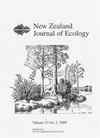就 "无捕食者新西兰 "提出正确的问题
IF 1.4
3区 环境科学与生态学
Q3 ECOLOGY
引用次数: 0
摘要
2016年启动的官方“无捕食者新西兰”计划是基于一个非常鼓舞人心的雄心壮志,即到2050年消灭新西兰各地所有入侵的啮齿动物(大鼠褐家鼠和鼠家鼠,但不包括小鼠小家鼠)、鼬类(白鼬、雪貂和鼬鼠)和负鼠(狐毛鼠)。其他人已经从事捕食者控制多年,但这次行动比以往任何一次行动都吸引了公众的想象力。它在地方范围内取得了一些令人印象深刻的成果,得到了当之无愧的赞誉。但其潜在的哲学世界观很少被讨论,我认为,这对其长期的、全国性的公众支持前景构成了风险。世界观比我们通常认识到的要重要得多,因为它们决定了我们提出的问题和我们认为合理的答案。新西兰环境管理的历史提供了一些发人深省的例子,说明项目管理者无意识地致力于无益的世界观。一些人忽略了隐藏的假设,例如,自上而下的人为死亡率施加方法可能超过具有弹性的害虫物种(如老鼠、白鼬、兔子(Oryctolagus cuniculus)或鹿(Cervus elaphus))的高自然死亡率。一些人提出了错误的问题,比如如何找到更好的方法来杀死害虫,而不是如何减少要杀死的害虫数量,这通常是由自下而上的食物供应控制的。有些人倾向于错误的结论,例如,当观察到害虫数量或分布的变化归因于人工手段的抑制时,即使自然手段是未知的。推理哲学表明,PF2050计划最好被视为一场两半场的比赛。首先,通过现有的自上而下的压制来短期防止对本地价值的损害,这种压制不能根除害虫种群,但至少可以保护最脆弱的本地动物,直到我们想出更好的方法来拯救它们。第二,长期清除有害生物种群,并辅以未来未知的减少有害生物繁殖和迁移的方法。本文章由计算机程序翻译,如有差异,请以英文原文为准。
Asking the right questions about Predator Free New Zealand
: The official Predator Free New Zealand programme launched in 2016 is based on a hugely inspiring, aspirational ambition to eradicate all invasive rodents (rats Rattus norvegicus and R. rattus but not mice Mus musculus ), mustelids (stoat Mustela erminea , ferret M. furo and weasel M. nivalis ) and possums ( Trichosurus vulpecula ) from throughout New Zealand by 2050. Others had already been doing predator control for years, but this campaign has caught the public imagination as no previous operation ever has. It is achieving some impressive results at local scales, to well-deserved acclaim. But its underlying philosophical world view is less often discussed, which, I argue, poses a risk to its prospects of long-term, national-scale public support. World views matter much more than we usually recognise because they determine the questions we ask and the answers we consider reasonable. The history of environmental management in New Zealand offers some thought-provoking examples of programme managers unconsciously committed to unhelpful world views. Some overlook hidden assumptions, e.g. that top-down methods of imposing artificial mortality can exceed the high natural mortality of resilient pest species such as rats, stoats, rabbits ( Oryctolagus cuniculus ), or deer ( Cervus elaphus ). Some ask the wrong questions, such as how to find better ways to kill pests rather than how to reduce the numbers to be killed, which is usually controlled by food supplies from the bottom up. Some favour the wrong conclusion, such as when an observed change in pest numbers or distribution is attributed to suppression by artificial means even when the natural means are unknown. The philosophy of reasoning suggests that the PF2050 programme could best be considered as a game of two halves. First, short-term prevention of damage to native values by existing top-down suppression that cannot eradicate pest populations but can at least protect the most vulnerable native fauna until we can think of better means to save them. Second, long-term removal of pest populations by supplementing suppression with unknown future methods of minimising pest fertility and immigration.
求助全文
通过发布文献求助,成功后即可免费获取论文全文。
去求助
来源期刊

New Zealand Journal of Ecology
环境科学-生态学
CiteScore
3.00
自引率
12.50%
发文量
35
审稿时长
>36 weeks
期刊介绍:
The New Zealand Journal of Ecology is a biannual peer-reviewed journal publishing ecological research relevant to New Zealand/Aotearoa and the South Pacific. It has been published since 1952 (as a 1952 issue of New Zealand Science Review and as the Proceedings of the New Zealand Ecological Society until 1977). The Journal is published by the New Zealand Ecological Society (Inc.), and is covered by Current Contents/Agriculture, Biology and Environmental Science, GEOBASE, and Geo Abstracts.
 求助内容:
求助内容: 应助结果提醒方式:
应助结果提醒方式:


